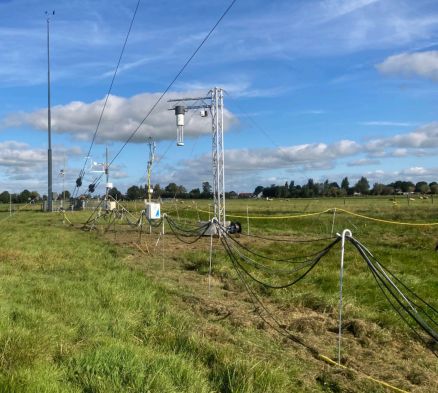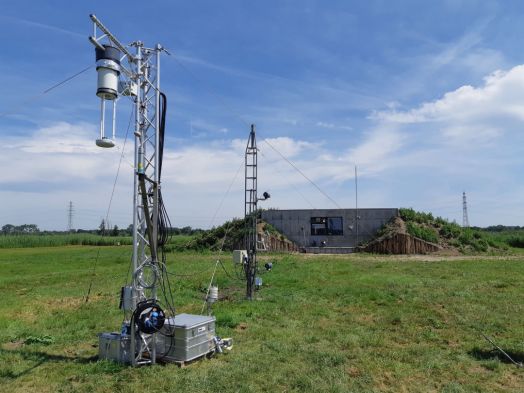 Home - Industrial solutions - Applications - Article Recommendation: Field comparison of two novel open-path instruments that measure dry deposition and emission of ammonia using flux-gradient and eddy covariance methods
Home - Industrial solutions - Applications - Article Recommendation: Field comparison of two novel open-path instruments that measure dry deposition and emission of ammonia using flux-gradient and eddy covariance methods A joint research team from the Netherlands Organisation for Applied Scientific Research (TNO) and the National Institute for Public Health and the Environment (RIVM) has published a research paper titled "Field comparison of two novel open-path instruments that measure dry deposition and emission of ammonia using flux-gradient and eddy covariance methods" in Atmospheric Measurement Techniques.
Experiment: Measurement of ammonia deposition using gradient and eddy covariance methods with two novel open-path instruments
Location: Ruisdael observatory station in the Netherlands
Partners: Joint research team from TNO and RIVM
Instrument Deployment: HT8700 Open-path NH3 Analyzer
Project Overview:
Dry deposition of ammonia (NH3) is the major factor of nitrogen deposition from the Dutch atmosphere to soil and vegetation, leading to eutrophication and loss of biodiversity. However, there is limited academic data on ammonia flux measurements, typically at monthly resolution at best. One significant reason for this situation is the difficulty of measuring ammonia flux under dry conditions. Previously, there has been no technology considered as the gold standard for ammonia flux measurement, making it complex to test new technologies and assess their quality.
This study demonstrates the results of a comparison between two novel measurement devices aimed at measuring ammonia dry deposition at half-hourly resolution. During a five-week comparison period, researchers simultaneously operated two optical open-path flux observation technologies at the Ruisdael observatory station in Cabauw, Netherlands: one using the gradient method flux technology, the novel RIVM-miniDOAS 2.2D instrument, and the other using the eddy covariance technology, the HT8700 Open-path NH3 Analyzer introduced by HealthyPhoton Technology Co., Ltd.

RIVM-miniDOAS 2.2D and HT8700 Open-path NH3 Analyzer deployed at the observation station in the Netherlands
Both RIVM-miniDOAS 2.2D and HT8700 Open-path NH3 Analyzer are open-path optical instruments that directly measure the ammonia content in the atmosphere during the measurement process. Additionally, they differ significantly in measurement principles and methods of deriving deposition values from measured concentrations.
Under uniform and obstacle-free wind conditions, both technologies show very similar results (r = 0.87). Observed fluxes range from about 80 ng NH3 m-2 s-1 deposition to about 140 ng NH3 m-2 s-1 emission. Both vastly different technologies yielded similar results in absolute flux values as well as real-time fluxes and concentration changes, confirming that both instruments are capable of measuring ammonia fluxes at high temporal resolution for at least several weeks. However, this correlation is also influenced by other factors, such as wind direction disturbances from nearby obstacles.

High consistency is shown in the ammonia flux variations measured by HT8700 and custom-made RIVM-miniDOAS 2.2D instruments
Furthermore, the paper discusses the technical performance (e.g., uptime, accuracy) and practical limitations of the two systems. The normal uptime of the miniDOAS system reached 100%, but both instruments were periodically calibrated during this activity (accounting for 35% of the seven-week normal uptime). While the HT8700 had lower data validity during rainy periods and shortly after rain, and the optical mirror coating used in early product versions may degrade, resulting in about 21% data loss (an upgraded version of the optical mirror surface has been delivered to customers to address this issue).
Although the independent operational time of HT8700 is limited under adverse weather conditions, the system can still provide good results under appropriate conditions, opening up promising prospects for future upgraded iterative versions that can be used for operational real-time ammonia flux monitoring applications.
The novel high-temporal-resolution data provided by these instruments will facilitate research on ammonia dry deposition processes, leading to a better understanding of ammonia deposition processes and improved parameterization of chemical transport models.

HT8700 equipped with upgraded optical mirror surface undergoing a new round of field tests
Through this study, we can see that both RIVM-miniDOAS 2.2D and HT8700 Open-path NH3 Analyzer have high potential and application value in measuring ammonia deposition. Although these two instruments differ in measurement principles and data processing methods, they can provide accurate and reliable measurement results under certain conditions. Furthermore, continuous technological upgrades and improvements have further enhanced the performance and stability of the HT8700 Open-path NH3 Analyzer, providing better tools and means for future ammonia deposition measurements.
In summary, this study provides new ideas and methods for ammonia deposition measurement, offering new tools and means for future environmental protection and ecological research. We believe that with continuous technological advancements and in-depth research, we will be able to better understand ammonia deposition processes and make greater contributions to environmental protection, ecosystem balance, and sustainable development.
Paper Reference:
Swart D. et al., Field comparison of two novel open-path instruments that measure dry deposition and emission of ammonia using flux-gradient and eddy covariance methods. Atmospheric Measurement Techniques, 16(2), 529-546, 2023.
https://doi.org/10.5194/amt-16-529-2023
 Tel:+86-156-1892-2826 Email:info@healthyphoton.com
Add:Room 305, Building 1, Zhongchuang Science Park, Jinyuan Road, Panhuo Street, Yinzhou District, Ningbo City,China
Tel:+86-156-1892-2826 Email:info@healthyphoton.com
Add:Room 305, Building 1, Zhongchuang Science Park, Jinyuan Road, Panhuo Street, Yinzhou District, Ningbo City,China


